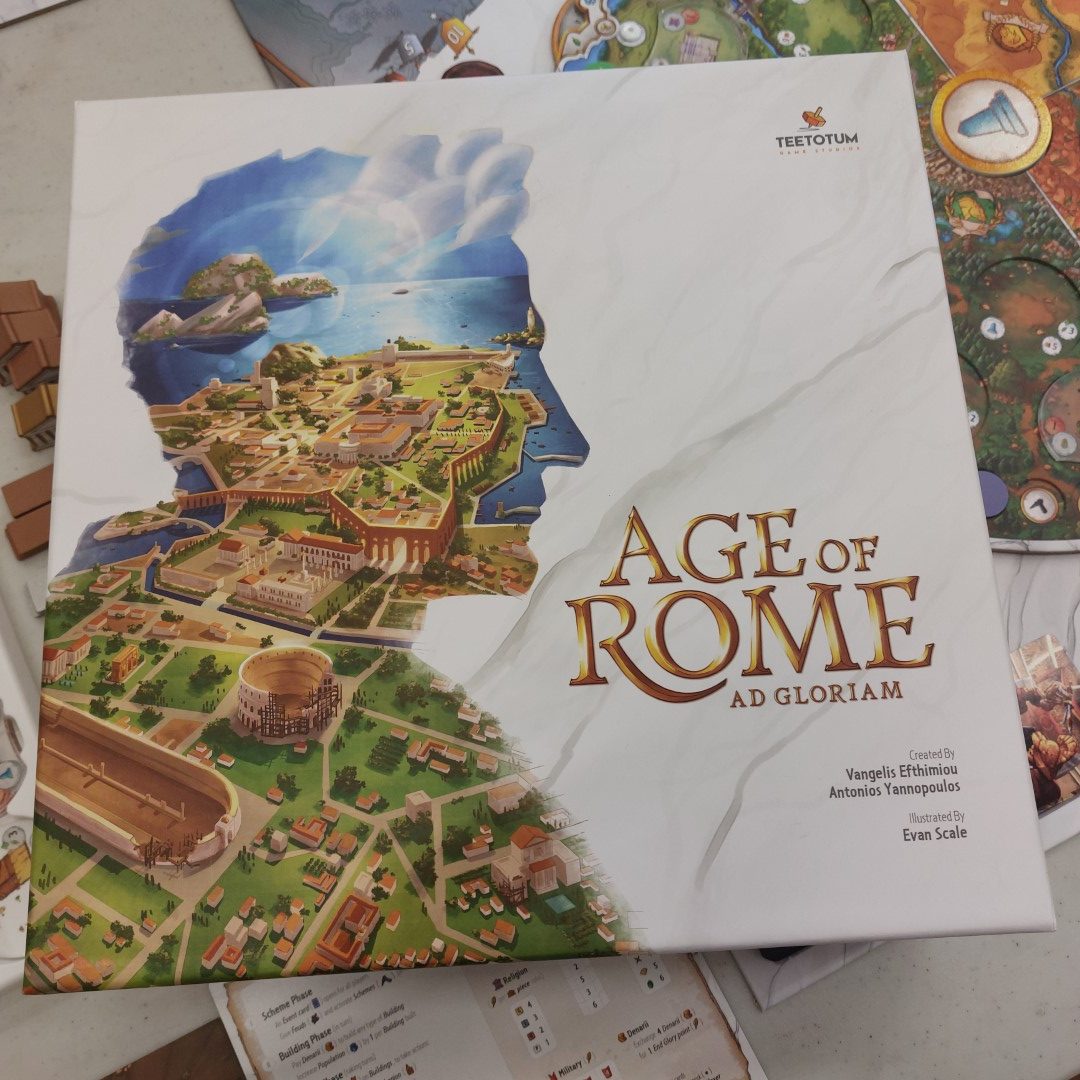Age of Rome is a worker placement game for 1-4 players in which you’ll build structures, manage workers and defeat your rivals to be the next empire. You play as a hero, and are playing during the transition to the Roman empire era. You’ll be balancing war, politics, trade and religion in the aim of glory, while scheming against each other. It’s essentially a worker placement game on a rondel board with a fair sprinkling of take that and randomness.
Age of Rome takes place over 9 rounds, which is broken into a number of phases the event phase, scheme phase, building phase, action phase and then income phase. It promises 9 rounds in about 60-90 minutes and I have to say having played a 4 player and 2 player game, including with players who are generally analysis paralysis prone we managed to find games into about 70 minutes. That didn’t include a teach, as we had all learnt the game in advance.
The event phase sees you draw an event card resolve its effect and then set the order of play, it also determines which way the board moves but you do that at the end of the round. The events are a mixture of whoever has the least gets X, or this action can’t be used. Fundamentally the whoever has the least is not necessarily the players in last, meaning that players ahead can just get more stuff, which is what we’ve seen across our plays. Now it’s nothing major it’s generally a couple of coins, but a couple of coins could be the difference between building and not.
We then come to the take that phase, officially known as the Scheme Phase. Players will have the option to resolve schemes if their scheme token on the board is in front of another player, this gives you the option to penalise the other player in some shape or fashion e.g. it could be destroying a step of the Pantheon, trashing a card, removing a vote, moving their military. You also get to move a fued token, which is probably the biggest plus as you could unlock the bonus tokens on your board. It is a take that phase and some players skipped this entirely, maybe its not in the spirit of the game, but it did feel like a passive threat at times. However, you will probably want to scheme once or twice to unlock a bonus icon. Everytime you scheme you move a feud token off your bonus icon row, and bonus icons allow you to essentially take a double action e.g. a trade bonus icon means you draw two cards, whilst a military bonus icon allows you to place two legions. So you’ll want to probably scheme just to unlock your icons and potentially cover your opponents.
The building phase sees players taking it in turns to build as many buildings as they want before the next player and so on. You can only build in the province in front of you, meaning as the board rotates at the end of each round you’ll find yourself with different choices and you’ll in a way be collectively contributing to provinces. Buildings are where you’ll place your followers (workers) during the action phase. Buildings come in five flavours, trade, politics, farming, military, religion. Each building comes in three different levels, with the level determining how many followers can be placed on the building e.g. a level 1 building can hold 1 follower. Building generates glory points and increases the provinces population, which determines income. There’s an incremental increase for upgrading, with the cost and victory points printed on the previous level. I would have loved to see buildings that interlock or slowly build up, the buildings are tokens, which is okay, but they did slide when we moved the board.
After each player has had the opportunity to build, the action phase takes place. Players will take it in turns to place a follower on a building in their province or on the central colosseum. The actions are;
Trade – draw a trade card
Military – place a legion
Politics – place a vote
Religion – build a level in your Pantheon
Farming – take gold equal to the amount specified by the round
Colosseum – gain a glory point
All of the actions largely contribute towards end game scoring, trade cards you’ll want sets of, so there’s a bit of incentive to dig through the deck, although it feels like there aren’t enough in the deck as we got through the deck surprisingly quickly and then found there were no trade cards of particular colours left. Voting sees you aiming for an in game majority, and end game position. Military is an area control, and there’s three regions you’ll need to compete over, building the Pantheon is a bit like a race in that the sooner you finish a level the more points you’ll gain. However, we did find by the end of the game actions felt like much of a muchness, with all the actions contributing a point, so the last round felt almost it contributed little to much in terms of changing the outcome of the game at that point.
At the start of the game you’ll likely only have one follower, as you score glory points, you’ll unlock more followers and reduce the threshold other players need to reach to gain a follower. Which I think is a neat mechanism, it offers a feeling of catch up and a lower level to be able to have more stuff.
The income phase is where you’ve the option to either take the income from your province or double the income for a penalty in glory points, early game it feels very worth while as the money earned is often worthwhile for the points increase in the following building phase. Late game, the glory point deduction doesn’t feel like a worthwhile investment. After the income you’ll recover followers, bonus tokens and activated scheme tokens and then rotate the board for the next round.
After nine rounds the game is done, and you’ll move into end game scoring. And as I’ve alluded to above, you’ll score points for almost every action you’ve taken, you’ll score points for final position in the Senates Column, sets of trade goods, for every piece in your Pantheon, personal quests and then 1 point for every 4 coins.
Overall, I was surprised by how quick Age of Rome is, it says 60-90 minutes on the box and that feels like a pretty accurate estimate. And I did like the catch up mechanism style of the points tracker, lowering the threshold for other players as players reach the goal. And I love a good rondel game, and for that Age of rome has my interest. However, I feel like Age of Rome needed a bit longer on the refinement table, for example the rulebook is too long, too wordy and it’s examples refer to characters who seemingly get mentioned for an example and then aren’t in the example. And despite its length, there were examples that could of been better explained e.g. it took us a few turns to realise that the first player marker sits on the province and doesn’t move. And I’d love the building tokens to interlock somehow rather than sitting on top and be a bit too easy to slide. Fundamentally there feels like a bit too much lack of player ability to influence events and that you can be somewhat at the whims of the event or the quest cards, for example one game all my quest cards required me to have sets of trade cards. I never managed a set! Another game, a player needed to have tokens in the senate and found themselves with none in the senate at the end of the game. Another game we found ourselves unable to take the farming action early on, when money feels so important. In each of our games, building tokens ran out so the building phase in round eight or nine was pointless, so I’m wondering if I’m missing a rule, but I can’t seem to see one.
As you know I rank games on the following:
Buy or play
Wait for sale or play if you like game XYZ
Avoid
Age of Rome sits somewhere between Wait for sale and avoid. It’s not the worst game I’ve played this year (I’m looking at your Beyond the rift..), and it feels like there are some interesting aspects here from the little twists on catch up mechanisms and the huge rondel board is great. But I can’t help but feel that if there was less spent on components and more time spent on rules and more on that final refinement there could be a game here that I’m recommending as a buy or play. If you enjoy rondel games and want to add another to your list, this could be for you, and equally if you want a worker placement with take that elements that us fairly easily to learn and teach despite the lengthy rulebook, then Age of Rome is worth a look. But I’m not sure it’s a game I’ll come back to.
Want to buy Age of Rome you can here: https://kienda.co.uk/strategy/4848-age-of-rome-792105104461.html
Disclaimer: I was sent a copy of Age of Rome to play and review. But all thoughts are my own.

